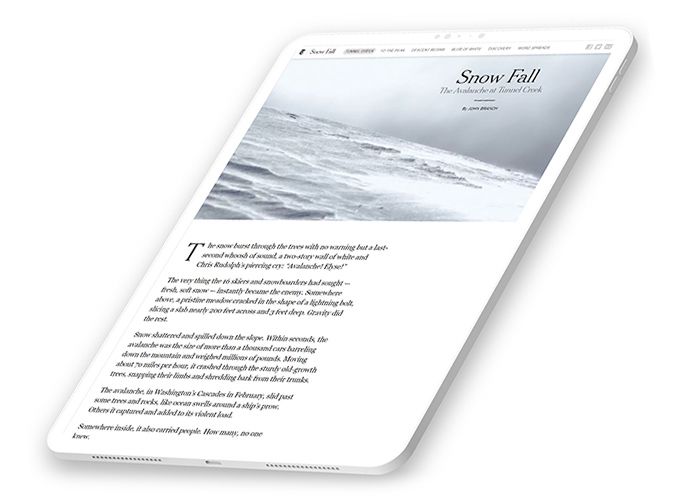A short history of digital storytelling

It’s a great time to be working in digital content. With no-code — or code-optional — platforms, powerful web browsers, and high-speed internet, it’s now possible for anyone to build stunning digital content at scale.
This wasn’t always the case. The impressive digital stories featured in this guide — and those featured in Shorthand’s regular newsletter — haven’t always been simple to build. Indeed, they haven’t always been technically possible to build.
In this section, we’re going to take a quick look at the history of digital storytelling. It’s a story of high ambition and false starts, with plenty of important lessons for anyone looking to invest in digital content creation.
The early years

Beep. Boop. Beep. Dum-de-dum-dum.
What’s that noise? Ah, yes, it’s the glorious sounds of the dial-up modem. Some of us might be nostalgic for those early years — pre-Google, pre-social media, pre-iPhone — but let’s be clear. It wasn’t a great time to be a reader of digital content.
This wasn’t necessarily obvious at the time. The late 1990s were years of high ambition. The Dotcom boom — followed, infamously, by the Dotcom bust — expressed much of this ambition, with variously-qualified futurists proclaiming the death of print and the inevitable rise of the web.
While these proclamations don’t seem too far from the mark today, they severely over-stated the short-term changes that were taking place at the time.
The internet was indeed beginning to disrupt a range of businesses, including print media. But that wasn’t because digital publications offered a better product to readers. It was because the internet offered a better product to advertisers.
The reading product on the web at the time left a lot to be desired. Digital content, such as it existed, was mostly vanilla facsimiles of print, with no real redeeming visual features. Images were few and far between, and stories that attempted anything remotely visually interesting stories were incredibly slow to load.
In sum: This was an era of high ambitions and limited technology. At the time, browsers were comparatively simple, and dial-up was still a thing. ‘Devices’ for accessing the web weren’t a thing, and most people read digital content from the (dis)comfort of their desktop computer.
Farming for content

As technology improved, the amount of content published to the web increased exponentially — literally, exponentially. The arrival and dominance of Google, coupled with the rise of social media platforms like Facebook, gave everyone — and not just major players — the chance to distribute content to motivated readers.
For content teams, this solved a major limitation of the early web. While the architecture of links was an organic way to make content visible, this wasn’t enough to justify large investments in content.
With Google, though, anyone could start producing content optimised for search queries. And if this ‘anyone’ knew what they were doing, they could also game those search engine algorithms with content that was friendly to Google, but aggressively unfriendly to human readers.
As a result, we saw the hideous rise of ‘content farms’, an umbrella term for organisations pumping out an enormous number of low quality, clickbait and SEO-bait articles. Tactics like keyword stuffing, paying for backlinks, and other ‘black-hat’ SEO tactics became popular.
As if things weren’t bad enough, this was also when online advertising stepped up a gear. Banner ads had always been around — but, as browsers became more powerful, many websites began to test their limits with an absolute symphony of corporate messages.
And what about the reader? Unfortunately, they were left in the cold, forced to fight away the hordes of calls-to-action in order to actually concentrate on the words on the screen. Unfortunately for them, the words, for their part, were often written more for Google’s algorithm than actual human beings, and much of the time weren’t worth the effort.
Bespoke and immersive

In the early-mid 2010s, the situation began to change for the better. First and foremost, Google made some significant changes to its algorithm, which killed some of the most egregious SEO practices in one fell swoop.
Second, some leading organisations began to rethink their approach to content. As digital devices took off, browsers improved in leaps and bounds, and the promise of high-speed internet became a reality (for some), content teams at major brands began to create what’s become known as ‘immersive’ content.
Unlike most web pages, immersive content stripped away extraneous distractions, producing material that was explicitly aimed at capturing and keeping the attention of the reader.
This led to stories that were clean to read, visually engaging, and sometimes even interactive.
The most famous of these stories came from journalism. “Snow Fall,” a product of the New York Times, was a longform feature story on the 2012 Tunnel Creek avalanche. Beautifully designed, with excellent scroll-triggered animations, the story won a Pulitzer Prize in 2013, and continues to be an excellent example of digital storytelling.

Many in the industry were hopeful that “Snow Fall” would be the future of journalism on the web. Unfortunately, these hopes didn’t last long, after it was revealed that developers (plural) had worked on the story for more than three months.
At this time, bespoke digital stories were great for readers, but were extremely expensive to produce. Few companies had the resources to produce a single story like “Snow Fall,” and fewer still had the resources to produce them at scale.
The rise of digital storytelling platforms

Here was the problem: How can content teams with limited resources create immersive reading experiences at scale? In the mid 2010s, a range of companies began to work on a solution.
In design, Canva and others helped non-designers create slick visual assets.
In website creation, too, dozens of competitors — including Squarespace, Weebly, and Wix — allowed non-developers to build new websites in minutes.
The same was true of digital content, where various companies arose to make it easier to create slick-looking content for the web. They generally fell into one of three categories, each aimed at a different kind of user, with different kinds of skills.
The first category is the developer tool, which makes it easier for developers to create more visually interesting and impressive web content. These tools are very powerful, but they don’t solve any problems for ambitious — but, sadly, developer-less — content teams.
The second is the web designer platform. These platforms are focused on helping designers create digital content experiences on their own, without necessarily writing code or collaborating with web developers. Often used by brands with in-house design teams, these tools are an excellent option for specialist designers, but they can be intimidating and complex for non-designers to use with confidence.
The third category is the digital storytelling platform. These platforms are aimed squarely at content teams themselves, which are usually populated with writers and editors. In most cases, web designers and web developers are scarce commodities, and they need to be carefully rationed. In essence, digital storytelling platforms aim to allow anyone to build a great-looking story, even those who can’t write a line of code or don’t know their kerning from their knolling.
Taken together, the rise of these platforms is good news for readers. They speak to a widespread desire to raise the bar on web content, and to use new technologies to create content that is more immersive, beautiful, and impactful.
Code — and web design — optional

These are exciting times for content teams. In the past, the perceived quality of the work output of content teams — that is, published stories, guides, blogs, guides, and more — were determined largely by budgets.
A larger budget meant that a team had access to developers and web designers, which in turn meant that it could publish immersive, interactive content. A smaller budget meant that content teams had to make do with their vanilla CMS.
In 2021, this is no longer the case. New platforms have democratised digital storytelling, giving every content team the opportunity to publish ambitious work.
Often, this change is talked about as the ‘no-code movement.’ This movement encompasses a huge variety of no-code or code-optional tools and platforms, from website builders to databases. Taken together, the impact of these tools is massive.
But for content teams, these tools only tend to solve one part of the problem, as these teams often lack both code and web design expertise. In many cases, ‘no-code’ content platforms seem to be built primarily for designers, which makes them inaccessible to many.
Accompanying the ’no-code’ movement, we’re seeing the rise of ‘design-done’ tools. Using flexible templates, these tools make it possible for non-designers to make great-looking stories. For many content teams, this is something like nirvana — the state of being, not the band — as it allows true autonomy over the entire content production workflow.
In this section of the Definitive guide to digital storytelling, we’ve sketched out a short history of digital storytelling. In the next section, we’ll run through some of digital storytelling’s many use cases.
